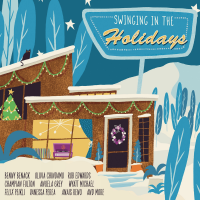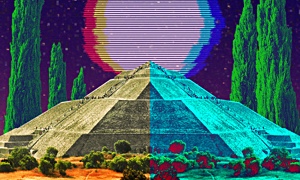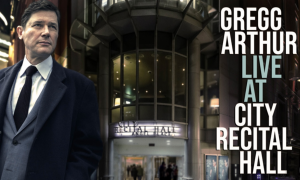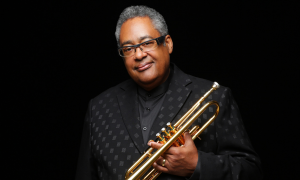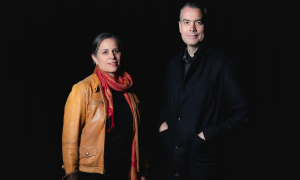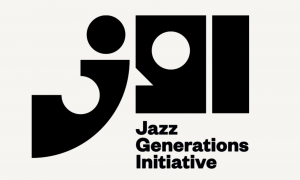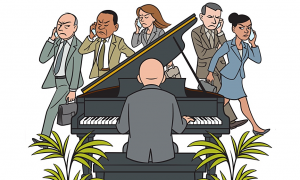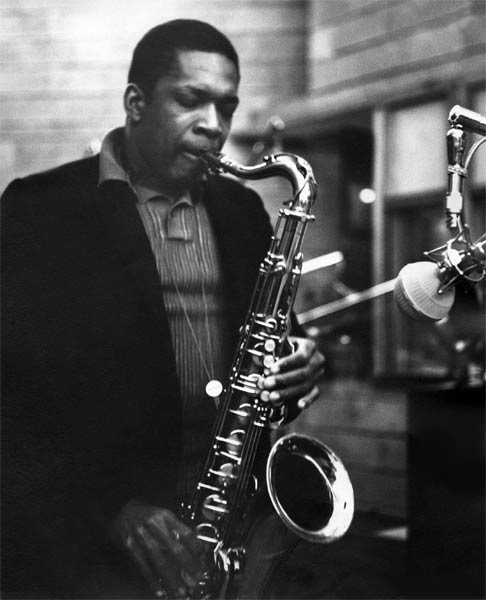
This is the first of an ongoing series where I'll look back at a jazz classic, arguing for its place as the greatest jazz album ever. It's one part love letter to pieces of music that are hardwired into jazz's DNA, one part go-to list for music fans curious about the music, and one part indulgence where I get to write about some of my favorite pieces of music.
Ask any jazz fan worth his or her salt what the best jazz album of all time is, and the conversation shouldn't get far (maybe three or four titles at best) before naming 'A Love Supreme.' It's arguably the greatest album by jazz's greatest saxophonist playing with his greatest band. Some may be partial to another Coltrane album like 'Blue Train,' 'Giant Steps' or even 'Live at the Village Vanguard' (which is a personal favorite), but personal preferences aren't what this is about. It's acknowledgment of a jazz masterpiece. 'A Love Supreme' is an album that changed the game for all musicians who played at the time and have come since then—I'll wager a princely sum that there isn't a jazz saxophonist out there who hasn't spent some time studying the mysteries of this album.
Whereas John Coltrane was famous for his lengthy excursions in Miles Davis' band and in his own studio and live performances, this music was far more than an amazing jam session or a great collection of songs, though it is both. The album is also the sound of Coltrane's spiritual awakening arranged as a four-part suite: 'Acknowledgement,' 'Resolution,' '"Pursuance' and 'Psalm.' The entire length is a concise 33 minutes, yet it is missing nothing.
Conceived by Coltrane during four days of contemplation in 1964, the album's material was fully formed at the end of his seclusion; everything including the transcendent title was worked out. Three months later, this timeless piece of music was recorded in a day. As with many great songs, the melodies are simple but memorable. It's also worth noting that the quartet was in top form at this point, having worked together steadily for three years together.
The album's first track. 'Acknowledgement,' opens with drummer Elvin Jones' Chinese gong. Calling the jazz faithful to prayer, Jones announces this unprecedented work with the an Eastern mystical sound as Coltrane on tenor throughout, pianist McCoy Tyner and bassist Jimmy Garrison come floating in. By the design of the composer, it's a look skyward in praise of God and announces that all that follows will be a communion. Then Garrison starts in with the signature four-note line, providing an earthly anchor. Coltrane begins his solo not coming to the theme immediately, instead building to it, then moving beyond. The band provides jet-powered wings that send him ever onward before finally returning to earth alongside that same bass line. In case you not sure what's going on, Coltrane lends a hand by chanting the title as if proselytizing to the masses that this is more than just music.
Watch John Coltrane's Live 'Acknowledgement' Video
'Resolution' begins with Garrison playing a complex set of chords by plucking two strings at the same time. Coltrane enters with the rest of the band for what is the strongest theme of the album. Again, the ascending notes are pushed furiously skyward as the saxophonist celebrates his inspiration. Tyner soon weighs in heavily with his own signature solo that ends with a complex but pounding set of chords that seemingly sends shock waves through the air, and he doesn't let up as Coltrane comes back in. Rather than take the energy up immediately, the saxophonist works his way somewhat atonally through the middle register at a jog while nonetheless remaining authoritative. Eventually, he scales ecstatic heights before easing into the final refrain.
Jones launches 'Pursuance,' the longest track at 10:42, with a minute-and-a-half solo. Coltrane offers an opening theme and then steps aside for Tyner to tackle the fast-paced tune with a probing solo that counters the block-like previous one. The band stretches out here with some of the finest, most high-energy playing between Jones and Coltrane (which is saying something), before the saxophonist drops out to give Jones a second solo section. The song ends with Garrison's solo segment, which offers a moment of contemplative respite from the exalted playing before it.
'Psalm' carries on the contemplative feel but adds more emotional drama as the band churns away. Jones, in particular, on kettledrums brings a magnificent gravity to the proceedings. Again, there is an elevated feel to the proceedings where it sounds like jazz but achieves a higher calling. Coltrane solos through much of the piece, in a gentle but not entirely melodic way—it's the sound of saxophonist fluttering away, locked into a trance and sounding as if his is only a conduit by which the horn is playing itself.
Amazon
Musically speaking, this album was a stepping stone that led the saxophonist further and further afield. While the soloing and group improvisation is quite advanced, Coltrane was still holding onto a minor key blues-based form at this point. Soon, Coltrane would move into his final and most avant-garde period, which only ended with his death from stomach cancer in 1967. These later albums are more adventurous, though there is no question that 'A Love Supreme' is a landmark that transcends jazz, music and art. It's a statement of faith where music says so much more than his words ever could.Ask any jazz fan worth his or her salt what the best jazz album of all time is, and the conversation shouldn't get far (maybe three or four titles at best) before naming 'A Love Supreme.' It's arguably the greatest album by jazz's greatest saxophonist playing with his greatest band. Some may be partial to another Coltrane album like 'Blue Train,' 'Giant Steps' or even 'Live at the Village Vanguard' (which is a personal favorite), but personal preferences aren't what this is about. It's acknowledgment of a jazz masterpiece. 'A Love Supreme' is an album that changed the game for all musicians who played at the time and have come since then—I'll wager a princely sum that there isn't a jazz saxophonist out there who hasn't spent some time studying the mysteries of this album.
Whereas John Coltrane was famous for his lengthy excursions in Miles Davis' band and in his own studio and live performances, this music was far more than an amazing jam session or a great collection of songs, though it is both. The album is also the sound of Coltrane's spiritual awakening arranged as a four-part suite: 'Acknowledgement,' 'Resolution,' '"Pursuance' and 'Psalm.' The entire length is a concise 33 minutes, yet it is missing nothing.
Conceived by Coltrane during four days of contemplation in 1964, the album's material was fully formed at the end of his seclusion; everything including the transcendent title was worked out. Three months later, this timeless piece of music was recorded in a day. As with many great songs, the melodies are simple but memorable. It's also worth noting that the quartet was in top form at this point, having worked together steadily for three years together.
The album's first track. 'Acknowledgement,' opens with drummer Elvin Jones' Chinese gong. Calling the jazz faithful to prayer, Jones announces this unprecedented work with the an Eastern mystical sound as Coltrane on tenor throughout, pianist McCoy Tyner and bassist Jimmy Garrison come floating in. By the design of the composer, it's a look skyward in praise of God and announces that all that follows will be a communion. Then Garrison starts in with the signature four-note line, providing an earthly anchor. Coltrane begins his solo not coming to the theme immediately, instead building to it, then moving beyond. The band provides jet-powered wings that send him ever onward before finally returning to earth alongside that same bass line. In case you not sure what's going on, Coltrane lends a hand by chanting the title as if proselytizing to the masses that this is more than just music.
Watch John Coltrane's Live 'Acknowledgement' Video
'Resolution' begins with Garrison playing a complex set of chords by plucking two strings at the same time. Coltrane enters with the rest of the band for what is the strongest theme of the album. Again, the ascending notes are pushed furiously skyward as the saxophonist celebrates his inspiration. Tyner soon weighs in heavily with his own signature solo that ends with a complex but pounding set of chords that seemingly sends shock waves through the air, and he doesn't let up as Coltrane comes back in. Rather than take the energy up immediately, the saxophonist works his way somewhat atonally through the middle register at a jog while nonetheless remaining authoritative. Eventually, he scales ecstatic heights before easing into the final refrain.
Jones launches 'Pursuance,' the longest track at 10:42, with a minute-and-a-half solo. Coltrane offers an opening theme and then steps aside for Tyner to tackle the fast-paced tune with a probing solo that counters the block-like previous one. The band stretches out here with some of the finest, most high-energy playing between Jones and Coltrane (which is saying something), before the saxophonist drops out to give Jones a second solo section. The song ends with Garrison's solo segment, which offers a moment of contemplative respite from the exalted playing before it.
'Psalm' carries on the contemplative feel but adds more emotional drama as the band churns away. Jones, in particular, on kettledrums brings a magnificent gravity to the proceedings. Again, there is an elevated feel to the proceedings where it sounds like jazz but achieves a higher calling. Coltrane solos through much of the piece, in a gentle but not entirely melodic way—it's the sound of saxophonist fluttering away, locked into a trance and sounding as if his is only a conduit by which the horn is playing itself.
Amazon
Postscript: For those who want to read the entire story behind the making of this album, I highly recommend Ashley Kahn's 'A Love Supreme: The Story of John Coltrane's Signature Album.'











